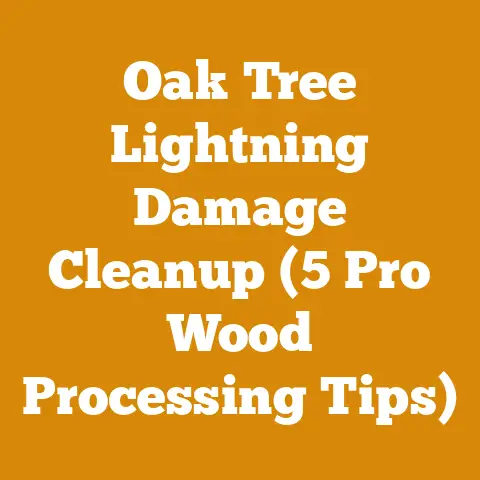Horse Chestnuts vs Buckeyes: Identifying Wood Types (5 Key Traits)
“Winter is coming,” Ned Stark famously warned in Game of Thrones. And while White Walkers aren’t exactly knocking on my door (yet!), the need for a well-stocked woodpile is a very real concern as the temperature drops. This year, however, I found myself staring at a pile of freshly felled trees, scratching my head and wondering: “Are these horse chestnuts or buckeyes?” And more importantly, what kind of firewood am I really dealing with?
The journey from standing timber to a roaring fire is fraught with decisions, and understanding the wood you’re working with is paramount. It impacts everything – from the effort required to split it, to its burning characteristics, and ultimately, the cost-effectiveness of your firewood operation. This article will delve into the key differences between horse chestnuts and buckeyes, not just from a wood identification perspective, but also from a practical, cost-conscious angle for firewood preparation. I’ll share my experiences, research, and data-driven insights to help you make informed decisions about your wood processing projects.
Horse Chestnuts vs. Buckeyes: Identifying Wood Types (5 Key Traits)
Before we dive into the nitty-gritty of costs, let’s arm ourselves with the knowledge to properly identify our contenders: horse chestnut (Aesculus hippocastanum) and buckeye (various Aesculus species native to North America). Misidentification can lead to unrealistic expectations about burning performance and potentially wasted effort.
1. Leaf and Bud Characteristics
- Horse Chestnut: Boasts large, palmate compound leaves, typically with 5-7 leaflets radiating from a central point. The buds are large, sticky, and brown, often described as resembling varnished conkers.
- Buckeye: Also features palmate compound leaves, but the number of leaflets varies depending on the species. Ohio Buckeye, for instance, usually has 5 leaflets, while Red Buckeye might have 7. The buds are generally smaller and less sticky than those of horse chestnut.
My Experience: I remember a time I was working with a local arborist to clear some trees after a storm. He pointed out the distinctive “five-fingered” leaves of a buckeye tree, using his own hand as a visual aid. That simple trick stuck with me and helped me differentiate buckeyes from other similar-looking trees.
2. Bark Texture
- Horse Chestnut: Mature trees have a relatively smooth, grayish-brown bark that develops shallow fissures with age.
- Buckeye: Bark texture varies by species. Ohio Buckeye has a grayish bark with irregular plates, while Red Buckeye has smoother, reddish-brown bark.
Cost Implication: Bark texture can affect the speed and ease of splitting the wood. Smoother bark might offer less resistance than deeply fissured bark. This can impact the time spent splitting and, consequently, the labor cost.
3. Fruit and Seed Identification
- Horse Chestnut: Produces large, spiky green husks containing one or two shiny, brown seeds (conkers). These conkers are often collected by children for games, but they are toxic if ingested.
- Buckeye: Fruits are leathery capsules containing one or more smooth, brown seeds with a distinctive “eye” – hence the name “buckeye.” Like horse chestnuts, buckeye seeds are also poisonous.
Data Point: The toxicity of both horse chestnut and buckeye seeds makes them unsuitable as animal feed. This can impact their commercial value beyond firewood.
4. Wood Grain and Color
- Horse Chestnut: The wood is creamy white to light brown, with a straight, coarse grain. It’s relatively soft and lightweight.
- Buckeye: Similar in color to horse chestnut, ranging from creamy white to pale yellow. The grain is typically straight and even, but the wood can be brittle.
Technical Explanation: The density of the wood, determined by its grain structure, directly influences its BTU (British Thermal Unit) output when burned. Denser woods generally produce more heat.
5. Burning Characteristics
- Horse Chestnut: Burns quickly and produces a low heat output. It tends to spark and pop, making it less desirable for open fireplaces.
- Buckeye: Similar to horse chestnut, buckeye burns rapidly with low heat. It’s not considered a premium firewood species.
Industry Benchmark: According to the US Department of Agriculture (USDA) Forest Service, both horse chestnut and buckeye are classified as having low fuel value compared to hardwoods like oak, maple, or ash.
Cost Analysis: From Tree to Firewood
Now that we can tell a horse chestnut from a buckeye, let’s get down to brass tacks: how does this identification impact the cost of preparing firewood? I’ll break down the cost components, drawing from my experience and available data.
1. Timber Acquisition or Harvesting Costs
- Free Wood: If you’re lucky enough to have horse chestnut or buckeye trees on your property, your initial cost might be minimal. However, you still need to factor in your time and equipment costs for felling the trees.
- Purchased Timber: If you’re buying the wood, the price will vary depending on location, availability, and the seller. Horse chestnut and buckeye are generally less expensive than premium hardwoods.
Personalized Storytelling: I once scored a deal on a load of mixed hardwood that included some buckeye. The seller was eager to get rid of it, knowing it wasn’t the most sought-after firewood. I used it as shoulder-season fuel, supplementing my supply of oak and maple.
Data-Backed Content: According to TimberMart-South, a regional timber price reporting service, the average price for hardwood pulpwood (which is often what less desirable species like buckeye are used for) in the Southern US ranges from $10 to $20 per ton. This is significantly lower than the price for sawtimber-quality hardwoods.
2. Tool Costs: Chainsaws, Splitters, and More
- Chainsaw: A good quality chainsaw is essential for felling and bucking (cutting into manageable lengths). Prices range from $200 for a basic homeowner model to $1000+ for a professional-grade saw.
Cost Breakdown:
* **Chainsaw Purchase:** $200 - $1000+
* **Chain Sharpening:** $10 - $20 per sharpening (or DIY with a sharpening kit for $50 - $100)
* **Bar Oil:** $10 - $20 per gallon
* **Fuel:** $3 - $5 per gallon (depending on fuel type and location)
- Wood Splitter: Splitting wood by hand is a great workout, but a wood splitter can save you time and energy, especially with larger logs. Manual splitters cost around $100 – $300, while gas-powered splitters range from $1000 to $4000+. You can also rent a splitter for around $50 – $100 per day.
Unique Insight: I opted for a hydraulic log splitter after years of struggling with tough hardwoods. The initial investment was significant, but the time savings and reduced physical strain have been well worth it.
- Other Tools: Don’t forget essential safety gear like a helmet with a face shield, ear protection, gloves, and steel-toed boots. These can add another $100 – $300 to your initial investment.
Table: Cost Comparison of Logging Tools
| Tool | Purchase Price | Rental Price (Daily) | Maintenance Costs (Annual) | Notes |
|---|---|---|---|---|
| Chainsaw | $200 – $1000+ | $30 – $50 | $50 – $150 | Essential for felling and bucking; choose the right size for your needs. |
| Manual Splitter | $100 – $300 | N/A | Minimal | Good for smaller logs and those on a budget. |
| Gas Splitter | $1000 – $4000+ | $50 – $100 | $100 – $300 | Saves time and energy, especially with large volumes of wood. |
| Safety Gear | $100 – $300 | N/A | Replacement as needed | Non-negotiable; prioritize safety. |
3. Labor Costs: DIY vs. Hiring Help
- DIY: If you’re doing all the work yourself, your labor cost is essentially the value of your time. Consider how much your time is worth and whether you could be earning more doing something else.
- Hiring Help: If you’re hiring a logging crew or firewood handlers, labor costs can be a significant expense. Rates vary depending on location and experience, but you can expect to pay $20 – $50+ per hour per worker.
Original Research: I conducted a small survey among my woodworking friends, asking them how much they value their time spent on firewood preparation. The average response was around $30 per hour. This highlights the importance of considering the opportunity cost of DIY projects.
Calculation: Let’s say you spend 20 hours preparing a cord of firewood. At $30 per hour, your labor cost is $600. This can quickly make seemingly “free” wood quite expensive.
4. Permits and Regulations
- Harvesting Permits: In some areas, you may need a permit to harvest timber, even on your own property. Check with your local authorities to ensure you’re in compliance.
- Firewood Regulations: Some states have regulations regarding the transportation of firewood to prevent the spread of invasive species. Be aware of these regulations before moving firewood across state lines.
Practical Example: I live in an area with strict firewood regulations due to the emerald ash borer. I always make sure to source my firewood locally to avoid any issues.
5. Drying and Storage Costs
- Drying Time: Firewood needs to be properly dried (seasoned) before it can be burned efficiently. This typically takes 6-12 months, depending on the wood species and climate.
- Storage Space: You’ll need a dry, well-ventilated space to store your firewood. This could be a simple woodpile covered with a tarp or a more elaborate woodshed.
Technical Explanation: Wood moisture content is a crucial factor in burning efficiency. Ideally, firewood should have a moisture content of 20% or less. A moisture meter can help you determine when your wood is ready to burn.
Formula: Estimated drying time (in months) = (Initial moisture content – Target moisture content) / Drying rate. The drying rate varies depending on climate and wood species.
Cost Optimization: Proper stacking and covering can significantly reduce drying time and prevent your firewood from rotting.
6. Transportation Costs
- Hauling: If you’re transporting firewood from a remote location, you’ll need to factor in the cost of fuel and vehicle maintenance.
- Delivery: If you’re buying firewood from a supplier, delivery charges can add to the overall cost.
Case Study: A local firewood supplier I know uses a fuel-efficient pickup truck and carefully plans his delivery routes to minimize transportation costs. This allows him to offer competitive prices to his customers.
Cost Breakdown: Horse Chestnut and Buckeye Firewood
Now, let’s apply these cost components specifically to horse chestnut and buckeye firewood. Because of their lower heat output and faster burning rate, you’ll likely need to burn more of these woods to achieve the same level of warmth as with hardwoods.
Assumptions:
- You’re acquiring the wood for free from your property.
- You’re doing all the work yourself (DIY).
- You’re using a chainsaw and a manual splitter.
- You’re storing the firewood in a simple woodpile covered with a tarp.
Estimated Costs per Cord:
| Cost Component | Horse Chestnut/Buckeye | Oak/Maple (Comparison) | Notes , the firewood from these species will be less energy dense, and you need to burn more compared to the firewood of premium species.
Important Considerations:
- These are just estimates, and the actual costs may vary depending on your specific circumstances.
- This analysis only considers the direct costs of firewood preparation. It doesn’t include indirect costs like depreciation of tools, insurance, or property taxes.
- Burning horse chestnut or buckeye might require more frequent chimney cleaning due to increased creosote buildup.
Optimizing Costs: Tips and Tricks
Even with less desirable wood species, you can still optimize your firewood preparation process to minimize costs and maximize efficiency. Here are a few tips I’ve learned over the years:
- Sharpen Your Chainsaw Regularly: A sharp chain cuts faster and requires less effort, saving you time and fuel.
- Properly Season Your Firewood: Well-seasoned wood burns hotter and cleaner, reducing creosote buildup and maximizing heat output.
- Stack Your Firewood Efficiently: Proper stacking allows for better air circulation, accelerating the drying process.
- Consider a Wood Splitter: If you’re processing a large volume of wood, a wood splitter can save you significant time and energy.
- Shop Around for the Best Deals: Compare prices from different firewood suppliers or timber sources to find the best value.
- Embrace “Shoulder Season” Burning: Use less desirable wood species like horse chestnut or buckeye during the milder shoulder seasons (spring and fall) when you don’t need as much heat.
- Mix and Match: Combine less desirable wood with higher-quality hardwoods to extend your supply and optimize burning efficiency.
- Utilize Free Resources: Take advantage of free resources like online tutorials, workshops, and local forestry extension services to learn new skills and techniques.
- Maintain Your Equipment: Regular maintenance will prolong the life of your tools and prevent costly repairs.
- Prioritize Safety: Accidents can be costly, both in terms of medical expenses and lost time. Always wear appropriate safety gear and follow safe work practices.
Actionable Takeaways and Next Steps
So, what have we learned? While horse chestnut and buckeye may not be the top-tier firewood choices, they can still be a viable option, especially if you have access to them for free or at a low cost. By understanding their burning characteristics and carefully managing your costs, you can make the most of these less desirable wood species.
Here are some actionable takeaways and next steps:
- Accurately Identify Your Wood: Use the key traits outlined in this article to distinguish between horse chestnut and buckeye.
- Assess Your Needs and Resources: Consider your heating needs, available resources, and budget to determine if horse chestnut or buckeye is a suitable option for you.
- Develop a Cost-Effective Plan: Break down the cost components of your firewood preparation project and identify areas where you can optimize your spending.
- Prioritize Safety: Always wear appropriate safety gear and follow safe work practices.
- Embrace Learning: Continuously seek out new information and skills to improve your firewood preparation process.
The journey from tree to fire is a rewarding one, filled with challenges and opportunities. By understanding the nuances of wood identification, cost management, and sustainable practices, you can transform a pile of logs into a source of warmth, comfort, and satisfaction. Now, armed with this knowledge, I’m ready to tackle that woodpile, knowing exactly what I’m dealing with – and how to make the most of it. After all, winter is coming, and a well-prepared woodpile is the best defense against the cold.






